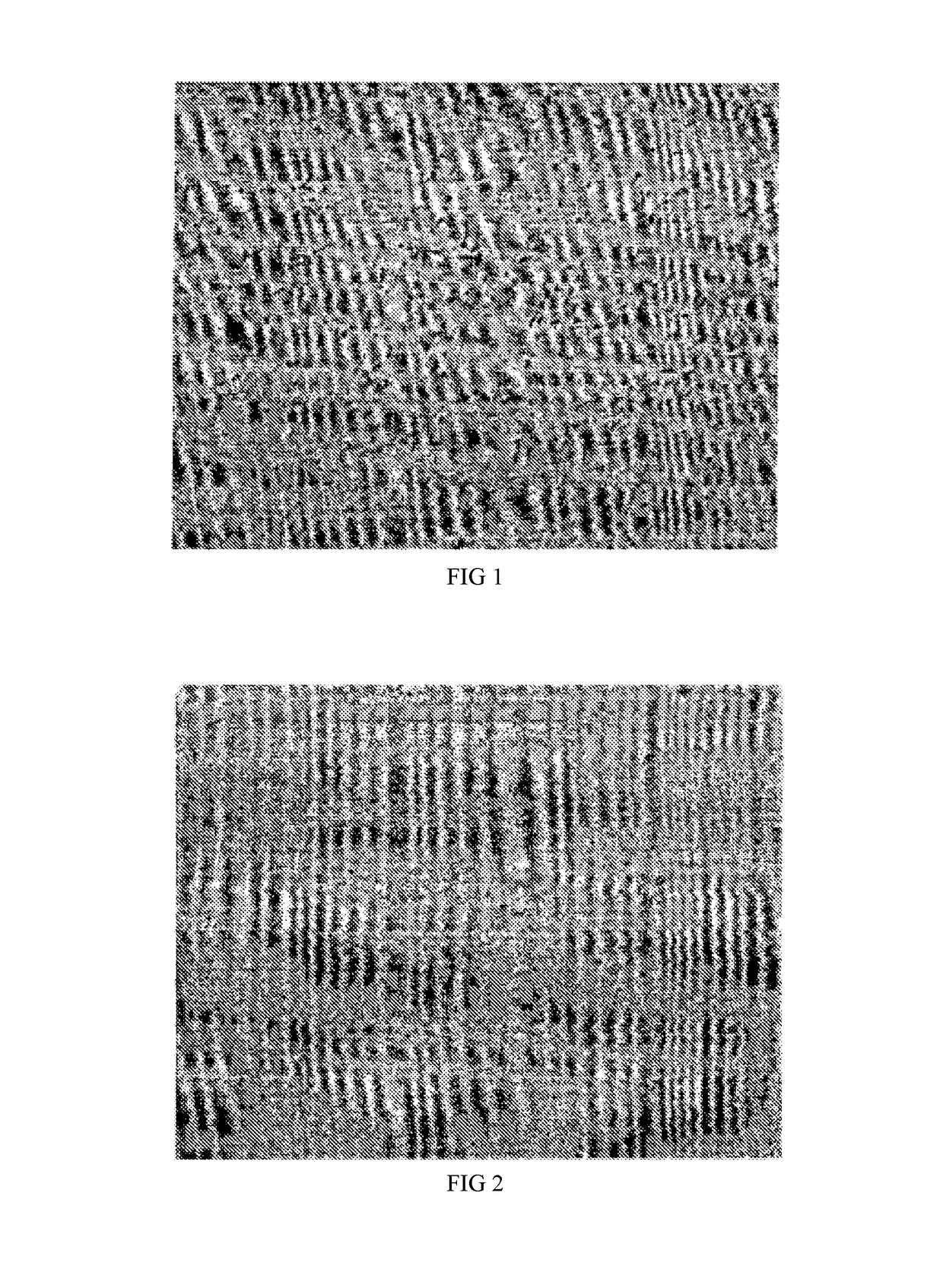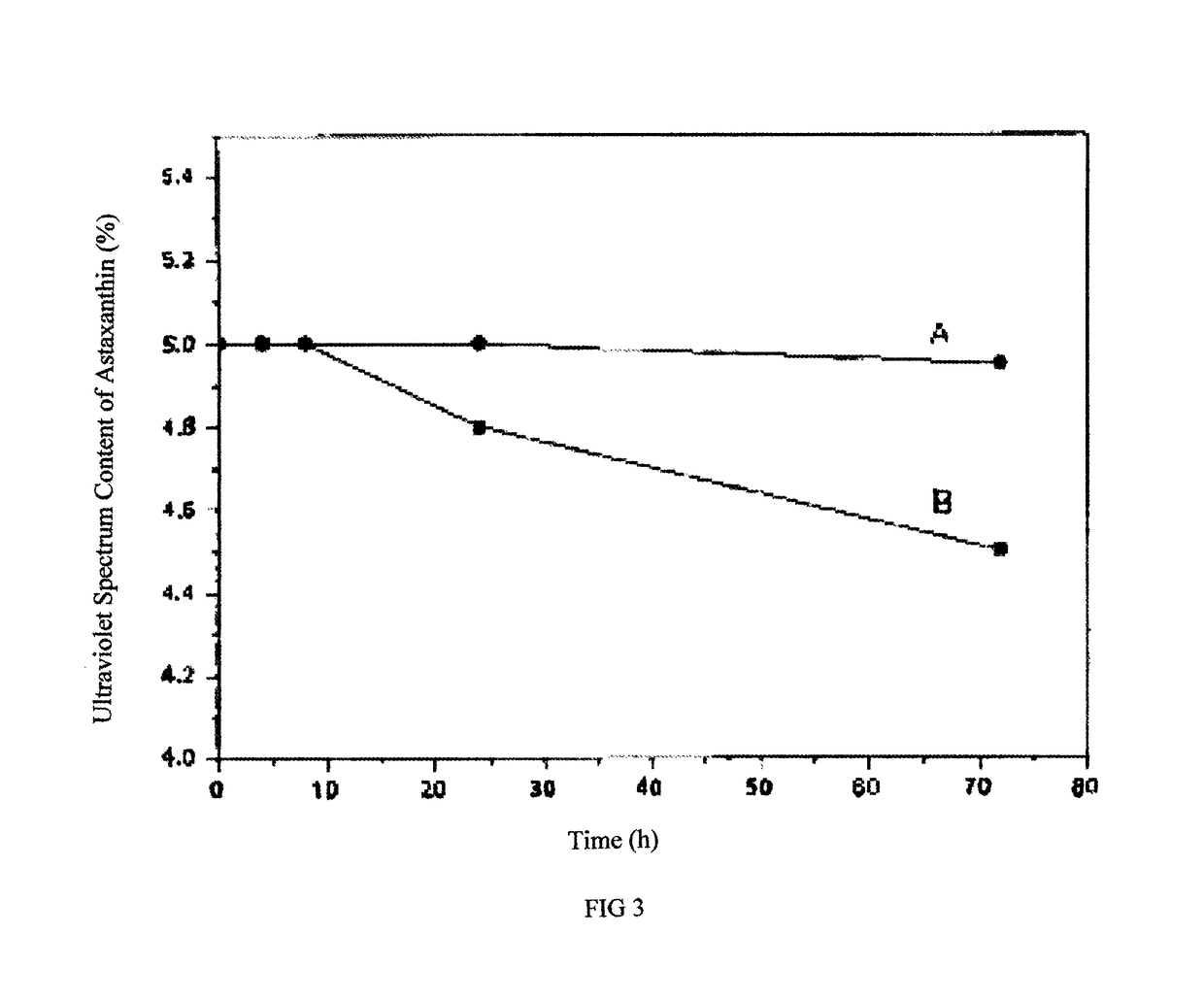Method for preparing oil-dispersible carotenoid preparation
a carotenoid and oil-dispersible technology, applied in the field of preparation of carotenoid, can solve the problems of difficult application in the oil phase system, inability to directly use, and poor chemical stability of carotenoid in oil solution, and achieve the effect of strong practicability and high stability
- Summary
- Abstract
- Description
- Claims
- Application Information
AI Technical Summary
Benefits of technology
Problems solved by technology
Method used
Image
Examples
embodiment 1
[0033
[0034]20 g astaxanthin coarse crystal was dissolved in 3 L dichloromethane to make astaxanthin solution; the astaxanthin solution was slowly added into a vessel containing 20 L ethanol in spraying form and the spraying speed was adjusted to make the particle size of precipitated amorphous astaxanthin particles less than 2 μm; a 0.3 μm millipore filter was used after spraying, the filter cake was washed with ethanol and pressed to dry to obtain a super refined astaxanthin powder filter cake; such filter cake was mixed with a 1 L water solution which contains 0.1 g vitamin C and 89.4 g gelatin, stirred and pulped, then was put in a high pressure homogenizer for 5 hours when the emulsion desolventized first in vacuum, and then 100 g astaxanthin microcapsule containing 10.5 g astaxanthin can be obtained after spray drying.
[0035]100 g astaxanthin microcapsule was mixed with 100 g soybean oil containing 0.2 g tocopherol and the mixture was grinded in a colloid mill for 3 times in a n...
embodiment 2
[0041
[0042]36.5 kg beta-carotene crystal and 260 kg dichloromethane were grinded in a sand mill to obtain a beta-carotene suspension liquid with an average particle size of 3 μm; 1 kg vitamin C sodium and 63.2 kg octenyl succinic starch ester were dissolved in 200 kg water and kept warm at 40° C. for later use.
[0043]The beta-carotene suspension liquid was fed into the bottom of a 4 L, 4-storeyed stirring vessel with height-diameter ratio of 4 via a pulp pump at a flow rate of 8 kg / h, dichloromethane which is preheated to 37° C. by a coiler preheater was fed into the bottom of the stirring vessel at a flow rate of 200 kg / h as well at the same time, the temperature in the vessel was controlled at 38° C. and pressure at 0.25 Mpa, was stay for about 15 minutes and a sample was taken for analysis to know that the dissolution into beta-carotene solution has been completed; the beta-carotene solution and isopropanol (at a flow rate of 1000 kg / h) was led into an over-gravity rotary bed crys...
embodiment 3
[0046
[0047]50 g canthaxanthin coarse crystal was dissolved in 2 L chloroform to make canthaxanthin solution; the canthaxanthin solution was slowly added into a vessel containing 20 L 95% ethanol in spraying form and the spraying speed was adjusted to make the particle size of precipitated amorphous canthaxanthin particles less than 2 μm; filtered with a 0.3 μm millipore filter after spraying, the filter cake was washed with ethanol and pressed to dry to obtain a super refined canthaxanthin powder filter cake; such filter cake was mixed with 1 L water solution which contains 0.5 g iso-vitamin C and 76.1 g Arabic gum, stirred and pulped, then put it in a high pressure homogenizer for 4 hours when the emulsion desolventized first in vacuum, and then 100 g canthaxanthin microcapsule containing 23.4 g canthaxanthin was obtained after spray drying.
[0048]100 g canthaxanthin microcapsule was mixed with 300 g sunflower seed oil containing 0.4 g BHT and the mixture was grinded in a colloid mi...
PUM
| Property | Measurement | Unit |
|---|---|---|
| particle size | aaaaa | aaaaa |
| particle size | aaaaa | aaaaa |
| size | aaaaa | aaaaa |
Abstract
Description
Claims
Application Information
 Login to View More
Login to View More - R&D
- Intellectual Property
- Life Sciences
- Materials
- Tech Scout
- Unparalleled Data Quality
- Higher Quality Content
- 60% Fewer Hallucinations
Browse by: Latest US Patents, China's latest patents, Technical Efficacy Thesaurus, Application Domain, Technology Topic, Popular Technical Reports.
© 2025 PatSnap. All rights reserved.Legal|Privacy policy|Modern Slavery Act Transparency Statement|Sitemap|About US| Contact US: help@patsnap.com


